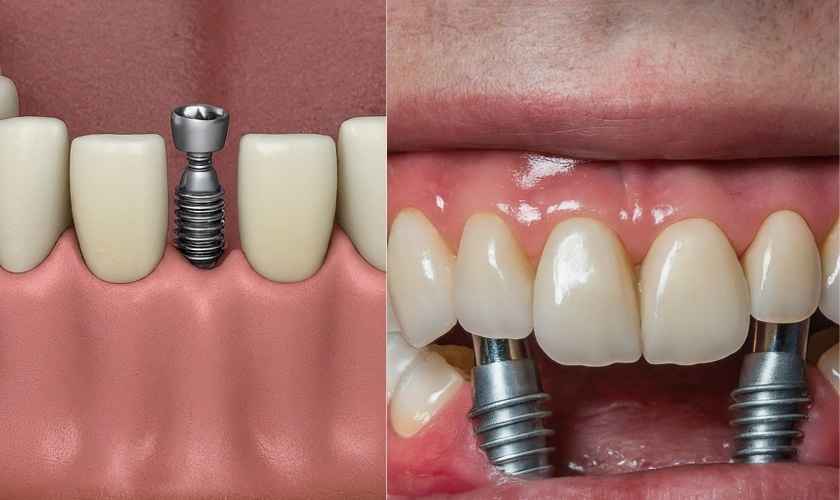The Facts About Dental Sense Uncovered
The Facts About Dental Sense Uncovered
Blog Article
Some Ideas on Dental Sense You Need To Know
Table of ContentsThe Definitive Guide for Dental SenseThe Only Guide to Dental SenseSome Known Incorrect Statements About Dental Sense The Definitive Guide for Dental Sense
are medical tools operatively implanted right into the jaw to bring back an individual's capability to eat or their look. They provide assistance for synthetic (fake) teeth, such as crowns, bridges, or dentures. When a tooth is shed as a result of injury or illness, a person can experience difficulties such as rapid bone loss, faulty speech, or adjustments to chewing patterns that lead to pain.Dental implant systems are composed of an oral implant body and dental implant abutment and might likewise consist of an abutment fixation screw. Cosmetic dentistry services. The oral implant body is operatively inserted in the jawbone instead of the tooth's root. The dental implant abutment is usually affixed to the dental implant body by the abutment addiction screw and extends with gum tissues right into the mouth to sustain the connected man-made teeth
(https://profile.hatena.ne.jp/dentalsense1/)Framework of The Dental Implant System choosing oral implants, talk to your dental provider concerning the potential advantages and risks, and whether you are a candidate for the treatment. Points to think about: Your overall health and wellness is a vital variable in determining whether you are a good candidate for dental implants, the length of time it will require to recover, and how long the implant may stay in area.
Smoking cigarettes may influence the recovery procedure and decrease the long-term success of the implant. The healing process for the implant body may take a number of months or longer, during which time you usually have a temporary joint instead of the tooth. the dental implant treatment: Thoroughly follow the oral health guidelines provided to you by your oral company.
Not known Details About Dental Sense
Implant failing can cause the need for another surgical treatment to take care of or change the implant system. Brings back the capacity to chew Recovers cosmetic look Aids keep the jawbone from shrinking because of bone loss Preserves the wellness of the surrounding bone and gum tissues Helps keep nearby (neighboring) teeth secure Boosts lifestyle Damage to bordering all-natural teeth throughout dental implant placement Injury to the surrounding tissues throughout surgery, such as sinus perforation Injury throughout surgical treatment (for example, fracture of bordering jawbone) Insufficient feature, such as seeming like the teeth do not attack together usually A sensation that the tooth hangs or twisting in location resulting from a joint screw loosening up Implant body failure (looseness of the dental implant body) as a result of systemic infection, which may be more probable in clients with uncontrolled diabetes mellitus as a result of regional infection in bone and gum tissues supporting the dental implant body as a result of delayed healing, which might be more probable in clients that smoke Difficulty cleaning the gums around the implant, resulting in inadequate oral health Unattended periodontal disease Post-surgical pins and needles as a result of nerve impingement or damages Constantly alert healthcare providers and imaging specialists that you have oral implants before any type of magnetic vibration imaging (MRI) or x-ray treatments.
FDA is not knowledgeable about any type of damaging events reported for MRI or x-ray procedures with dental implants. Oral implants systems are typically made from materials that adhere to worldwide agreement standards of the International Organization for Standardization (ISO) or ASTM International. These criteria have details of what makes a secure material.

An oral implant is a structure that changes a missing tooth. With screw-like devices, the cosmetic surgeon inserts a dental implant into the jawbone, and it functions as an anchor for an artificial tooth, called a crown. A device called an abutment attaches the man-made tooth to the dental implant. The crown is personalized to fit the person's mouth and match the shade of their teeth.
Unknown Facts About Dental Sense
Some people are not qualified for dental implant surgical treatment. It is for oral surgeons to operate on individuals with: acute illnessuncontrollable metabolic diseasebone or soft Home Page cells disease or infectionIf these concerns are resolved, a person can have the surgical treatment. In, dental doctors avoid running on individuals with: If people with any of the above go through oral implant surgical treatment, there is a greater danger of the implant falling short.

Dental dental implant surgical procedure is a personalized process. Provide you time to recover. Attach the post and final crown, bridge or denture.
Next off, your surgeon will carefully place the oral implant into your jaw. Finally, your surgeon will rearrange your periodontals and close the incision with stitches. If your implant is near the front of your mouth, your dentist will make a momentary tooth for you to put on until you heal. In this way, you won't have a gap in your smile while you recoup.
The Definitive Guide to Dental Sense
Your supplier can tell you what to expect in your situation. During the recovery phase, your jawbone ought to fuse to the oral implant. This procedure, called osseointegration, is critical for security and lasting success. This procedure can take anywhere from three to nine months. Sometimes, it may take much longer.
As soon as your dental implant heals, your dental practitioner can affix the joint (small adapter post) and your final restoration (crown, bridge or denture). This normally takes concerning one hour to finish and may require a 2nd minor surgical treatment. You should not feel any type of discomfort throughout your dental implant treatment due to the fact that your service provider will certainly make use of medication to numb your gum tissues.
Report this page